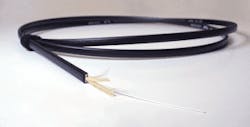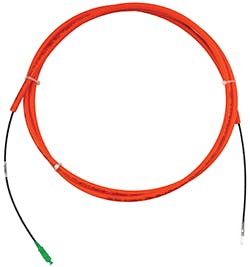Solutions Evolved to Meet Providers’ Needs —
For many years there really has been only one solution for FTTx connectivity in what is known as The Last Mile (well, actually it’s only the last hundreds of feet): the proverbial flat drop. The flat drop for fiber was really just a re-purpose of a popular copper drop wire used in telco for as long as most of us can remember. And while it is not a bad solution, in recent years there have been advancements in fiber drop and termination technology where significant savings can be realized, depending on where and when they are used.
The Old Standby
Figure 1. Industry standard Flat Drop Cable.
The flat drop for fiber, as mentioned earlier, is really just an adaptation of a standard copper drop. Its familiar form and low cost make it an attractive choice, especially in rural areas and aerial applications. This old standby is one of the least expensive when we look at capital expenditures in a fiber deployment. That said, it offers little in terms of restorability and upgradability. (See Figure 1.)
As networks evolve, the drawbacks associated with flat drop become much less attractive within a drop solution. Because flat drop cable is traditionally not pre-terminated, the installation costs (for splicing on the connector) are higher than pre-connectorized drops, and when a flat drop has been pre-terminated, slack storage becomes an issue.
Another drawback of flat drop is its design for use in the OSP environment where it would require an additional splice and enclosure when the drop needs to enter into an indoor space.
Interestingly, an entire niche market has been developed to find a way to aesthetically manage this.
Enter Microduct and Terminals
With the advent of microducts, the drop world began to change. Because homes and businesses alike were developing a greater hunger for fiber, methods to deliver and terminate multiple fibers were needed. Microduct was an obvious solution because of its small size, durability, and ease of use.
This, coupled with microfibers, pushable fiber, and small form factor terminals helped to ease network planner’s pain (especially those in urban environments). Because microducts and the fiber drops used in them allow placement in almost any environment, they are a great solution for densely populated residential areas, business parks, MDUs, etc.
Figure 2. Varieties of microduct for plenum, riser, and outside plant applications.
Additionally, because the network planner can choose from a variety of fiber counts, these ducted drops allow for greater flexibility in design. (See Figure 2.)
As fiber drops evolved, so have the terminals that accepted them. Because installers are now placing microducts from point to point, they need a way to "land" the ducts at both the street and the home or business. New terminal designs allow for the installer to simply plug the duct into the base of the terminal and have a neat, watertight seal in a very small footprint — something very appealing in dense urban environments.
The only real drawback of this approach is that it takes 2 passes (and 3 steps) to install the service: 1 to install the microduct, and another to install and splice the fiber.
This is partially remedied by the advent of pushable, pre-terminated fiber drops. These factory terminated drop assemblies allow an entry-level technician to both place the fiber and easily terminate it without the need of a splicer.
Pushing to the Next Step
Pushable fiber is a relatively new term that means the fiber is stiff enough to be pushed into a microduct and to a terminal. Since they are pre-connectorized, they allow for the first true plug-and-play design solutions. This saves time and money in that there is no splicing; an entry-level tech can install and terminate at the same time, and it is fully restorable without removing the connectors.
InvisiLight® Solution for Deploying Fiber
April 2, 2022Go to Market Faster. Speed up Network Deployment
April 2, 2022Episode 10: Fiber Optic Closure Specs Explained…
April 1, 2022Food for Thought from Our 2022 ICT Visionaries
April 1, 2022Another significant leap in drop technology was the release of the Multi-fiber Push-On connectors or MPO. These give the designer and installer another tool in their toolbox for FTTx plug-and-play designs. Because these connectors can have up to 24 pre-terminated fibers, the designer can now have the advantages of plug-and-play, not just from the terminal to the end user, but from the distribution hub to terminal or multiple terminals, without the hassle (and cost) associated with splicing.
These MPO connectors are seeing use in everything from FTTH to MDU to business class and wireless deployments.
One drawback of these connectors is the larger footprint does not allow them to be installed in microducts.
That led to the Pushable MPO Connector. This connector is housed in a protective enclosure small enough to pass through a microduct and, once installed, a housing snaps onto the end and plugs in. This, combined with new MPO ready terminals, allows the plug-and-play approach to be used in virtually any environment from rural FTTH deployments, to dense urban FTTH, fiber to the wireless tower, MDU, and the multi-use building where both residential and commercial spaces are combined under one roof. New MPO-ready terminals allow network operators to deploy both residential and commercial services in a single terminal, allowing for greater flexibility and savings.
And Then Came…
The next evolution was really a remake of an older product. Cable in Conduit (CIC) has been around for many years, however, it was not widely used as a drop solution until recently. There seemed to be a fear of placing both duct and fiber during construction phases because of the risk of damage to the fiber.
An added negative: if you wanted the CIC assembly pre-connectorized, the microduct would have to be split longitudinally in order to adjust the length. Not a terrible thing to do if you were only cutting a foot or so off of the length. However, if you had to cut longer lengths, it became very cumbersome.
Some indoor versions of CIC have been used in MDU deployments, providing some real savings to an installer as well as providing a pathway that is considered restorable.
The caveat to the restorability of traditional CIC is that you still have to cut off the connector and re-splice both ends of the fiber because the connectors are simply too big to pass through the duct.
Pre-Terminated CIC
Decision time. In choosing which drop solution best fits your project, designers and installers alike can ask themselves a few questions that will help in the selection of their fiber drops:
- Is the old standby (flat drop) sufficient for my needs?
- Do I need or want a pathway for future expansion or repairs?
- Would I prefer a one-pass CIC type product,or is a 2-pass product good enough?
- Do I need or want a pre-connectorized solution?
- Is there another evolution of fiber drop?
Once you have answered these questions, you can decide which type of product best suits your needs. For example:
• If restorability is not a concern and you don’t mind splicing, then perhaps the flat drop is fine for your situation.
• If you want to be able to restore or upgrade in the future, then the microduct solution may be best for your application.
• If you want what has been considered a one pass solution in the past, (pre-connectorized did not always exist) then the CIC path is a way for you to go.
• Clearfield’s FieldShield D-ROP product provides a pre-connectorized, one-pass, restorable CIC solution. The name D-ROP is an acronym for Drop-Restorable One pass Pre-terminated. It takes all of the benefits of the previous drop types and combines them into a single one-pass drop assembly. (See Figure 3.)
Figure 3. CIC: Pre-terminated fiber pre-placed in microduct.
Equipped with these choices, you can ask yourself which type of drop solution works best and choose the product that best suits your particular network plan.
Looking at fiber deployments and taking into account factors such as different environments, how much time to deploy the network, construction costs, both initial capital outlay, downstream maintenance, and, as a whole, the total cost of ownership, we should evaluate all options.
Like this Article?
Subscribe to ISE magazine and start receiving your FREE monthly copy today!
The best answer is to review old and new solutions to see which one, or what combination of some, best serves the needs to get the network deployed, and then also considering how they will impact the ongoing maintenance and upgrading of the network. Only after you do that homework will you be able to choose how to effectively deploy a robust fiber network.












